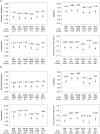Comparison of multiple obesity indices for cardiovascular disease risk classification in South Asian adults: The CARRS Study
- PMID: 28448582
- PMCID: PMC5407781
- DOI: 10.1371/journal.pone.0174251
Comparison of multiple obesity indices for cardiovascular disease risk classification in South Asian adults: The CARRS Study
Abstract
Background: We comparatively assessed the performance of six simple obesity indices to identify adults with cardiovascular disease (CVD) risk factors in a diverse and contemporary South Asian population.
Methods: 8,892 participants aged 20-60 years in 2010-2011 were analyzed. Six obesity indices were examined: body mass index (BMI), waist circumference (WC), waist-height ratio (WHtR), waist-hip ratio (WHR), log of the sum of triceps and subscapular skin fold thickness (LTS), and percent body fat derived from bioelectric impedance analysis (BIA). We estimated models with obesity indices specified as deciles and as continuous linear variables to predict prevalent hypertension, diabetes, and high cholesterol and report associations (prevalence ratios, PRs), discrimination (area-under-the-curve, AUCs), and calibration (index χ2). We also examined a composite unhealthy cardiovascular profile score summarizing glucose, lipids, and blood pressure.
Results: No single obesity index consistently performed statistically significantly better than the others across the outcome models. Based on point estimates, WHtR trended towards best performance in classifying diabetes (PR = 1.58 [1.45-1.72], AUC = 0.77, men; PR = 1.59 [1.47-1.71], AUC = 0.80, women) and hypertension (PR = 1.34 [1.26,1.42], AUC = 0.70, men; PR = 1.41 [1.33,1.50], AUC = 0.78, women). WC (mean difference = 0.24 SD [0.21-0.27]) and WHtR (mean difference = 0.24 SD [0.21,0.28]) had the strongest associations with the composite unhealthy cardiovascular profile score in women but not in men.
Conclusions: WC and WHtR were the most useful indices for identifying South Asian adults with prevalent diabetes and hypertension. Collection of waist circumference data in South Asian health surveys will be informative for population-based CVD surveillance efforts.
Conflict of interest statement
Figures


References
-
- Murray CJL, Barber RM, Foreman KJ, Ozgoren AA, Abd-Allah F, Abera SF, et al. Global, regional, and national disability-adjusted life years (DALYs) for 306 diseases and injuries and healthy life expectancy (HALE) for 188 countries, 1990–2013: quantifying the epidemiological transition. The Lancet. 2015; - PMC - PubMed
-
- Popkin BM, Adair LS, Ng SW. Global nutrition transition and the pandemic of obesity in developing countries. Nutr Rev. 2012;70: 3–21. doi: 10.1111/j.1753-4887.2011.00456.x - DOI - PMC - PubMed
-
- Gelber RP, Gaziano JM, Orav EJ, Manson JE, Buring JE, Kurth T. Measures of Obesity and Cardiovascular Risk Among Men and Women. J Am Coll Cardiol. 2008;52: 605–615. doi: 10.1016/j.jacc.2008.03.066 - DOI - PMC - PubMed
-
- Mohan V, Deepa M, Farooq S, Narayan KMV, Datta M, Deepa R. Anthropometric cut points for identification of cardiometabolic risk factors in an urban Asian Indian population. Metabolism. 2007;56: 961–968. doi: 10.1016/j.metabol.2007.02.009 - DOI - PubMed
Publication types
MeSH terms
LinkOut - more resources
Full Text Sources
Other Literature Sources
Medical
Research Materials

